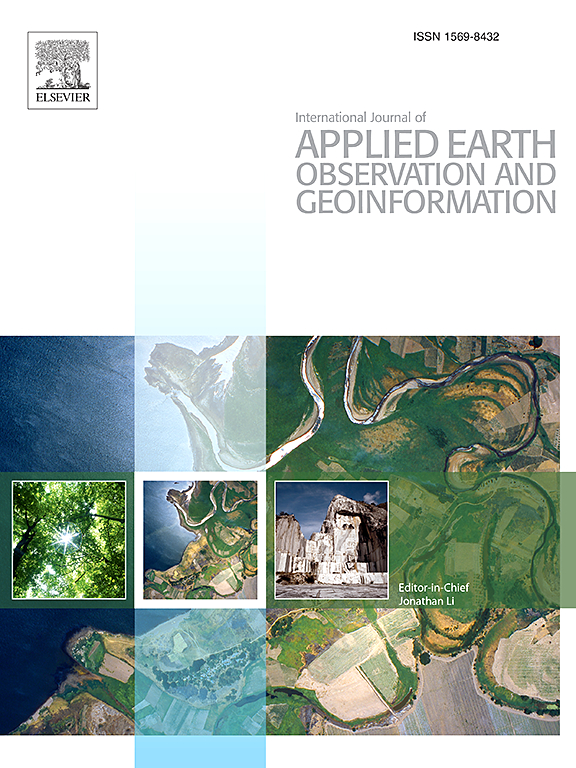利用傅立叶级数分析生成晴空条件下MODIS每小时地表温度
IF 7.6
Q1 REMOTE SENSING
International journal of applied earth observation and geoinformation : ITC journal
Pub Date : 2025-02-01
DOI:10.1016/j.jag.2024.104341
引用次数: 0
摘要
具有高时空分辨率的地表温度(LST)数据被用于许多研究,如评估气候变化、陆-气相互作用、地表能量平衡等。然而,云层以及地球静止轨道卫星和极轨卫星的局限性阻碍了高质量热红外数据的收集。本研究的目的是利用中分辨率成像光谱仪(MODIS)每日4次观测,生成每小时的地表温度数据。采用多通道奇异谱分析(M−SSA)算法重建MODIS年LST时间序列中由于云层造成的数据丢失。随后,基于MODIS每天4次观测数据,采用傅立叶级数分析生成逐时LST数据。利用Meteosat-9的每小时地表温度数据和八个不同Ameriflux站点的地表土壤温度数据,对开发的傅立叶级数模型进行了评估。傅里叶级数模型的评估表明,在伊朗,Meteosat-9卫星每小时地表温度数据与使用四个同时MODIS观测的傅里叶级数模型每小时地表温度数据之间的均方根误差(RMSE)和决定系数(R2)平均分别为1.70开尔文和0.98开尔文。Ameriflux站点的地表土壤温度数据与4次MODIS观测数据的平均RMSE和R2分别为1.15 K和0.98。值得注意的是,在日出和日落时观察到最高的RMSE。本文章由计算机程序翻译,如有差异,请以英文原文为准。
Generating MODIS hourly land surface temperature under clear sky conditions using Fourier series analysis
Land surface temperature (LST) data with high temporal and spatial resolution are used in many studies, e.g. to assess climate changes, land–atmosphere interactions, surface energy balance, etc. However, clouds and the limitations of geostationary and polar orbiting satellites hinder the collection of high-quality thermal infrared (TIR) data. This research aims to generate hourly LST data from the Moderate Resolution Imaging Spectroradiometer (MODIS) with four daily observations. The Multi-channel Singular Spectrum Analysis (M−SSA) algorithm was used to reconstruct lost data due to clouds in the MODIS annual LST time series. Subsequently, Fourier series analysis was employed to generate hourly LST data based on the four MODIS observations per day. The developed Fourier series model was evaluated using hourly LST data from Meteosat-9 and ground surface soil temperature data at eight different Ameriflux sites. The evaluation of the Fourier series model showed that the Root Mean Square Error (RMSE) and coefficient of determination (R2) between the hourly LST data from the Meteosat-9 satellite and the hourly LST data generated by the Fourier series model using four simultaneous MODIS observations averaged 1.70 Kelvin and 0.98, respectively, throughout Iran. For Ameriflux sites, the average RMSE and R2 were 1.15 K and 0.98 between the surface soil temperature data and the surface soil temperature data generated using four simultaneous MODIS observations per day, respectively. Notably, the highest RMSE was observed during sunrise and sunset.
求助全文
通过发布文献求助,成功后即可免费获取论文全文。
去求助
来源期刊

International journal of applied earth observation and geoinformation : ITC journal
Global and Planetary Change, Management, Monitoring, Policy and Law, Earth-Surface Processes, Computers in Earth Sciences
CiteScore
12.00
自引率
0.00%
发文量
0
审稿时长
77 days
期刊介绍:
The International Journal of Applied Earth Observation and Geoinformation publishes original papers that utilize earth observation data for natural resource and environmental inventory and management. These data primarily originate from remote sensing platforms, including satellites and aircraft, supplemented by surface and subsurface measurements. Addressing natural resources such as forests, agricultural land, soils, and water, as well as environmental concerns like biodiversity, land degradation, and hazards, the journal explores conceptual and data-driven approaches. It covers geoinformation themes like capturing, databasing, visualization, interpretation, data quality, and spatial uncertainty.
 求助内容:
求助内容: 应助结果提醒方式:
应助结果提醒方式:


